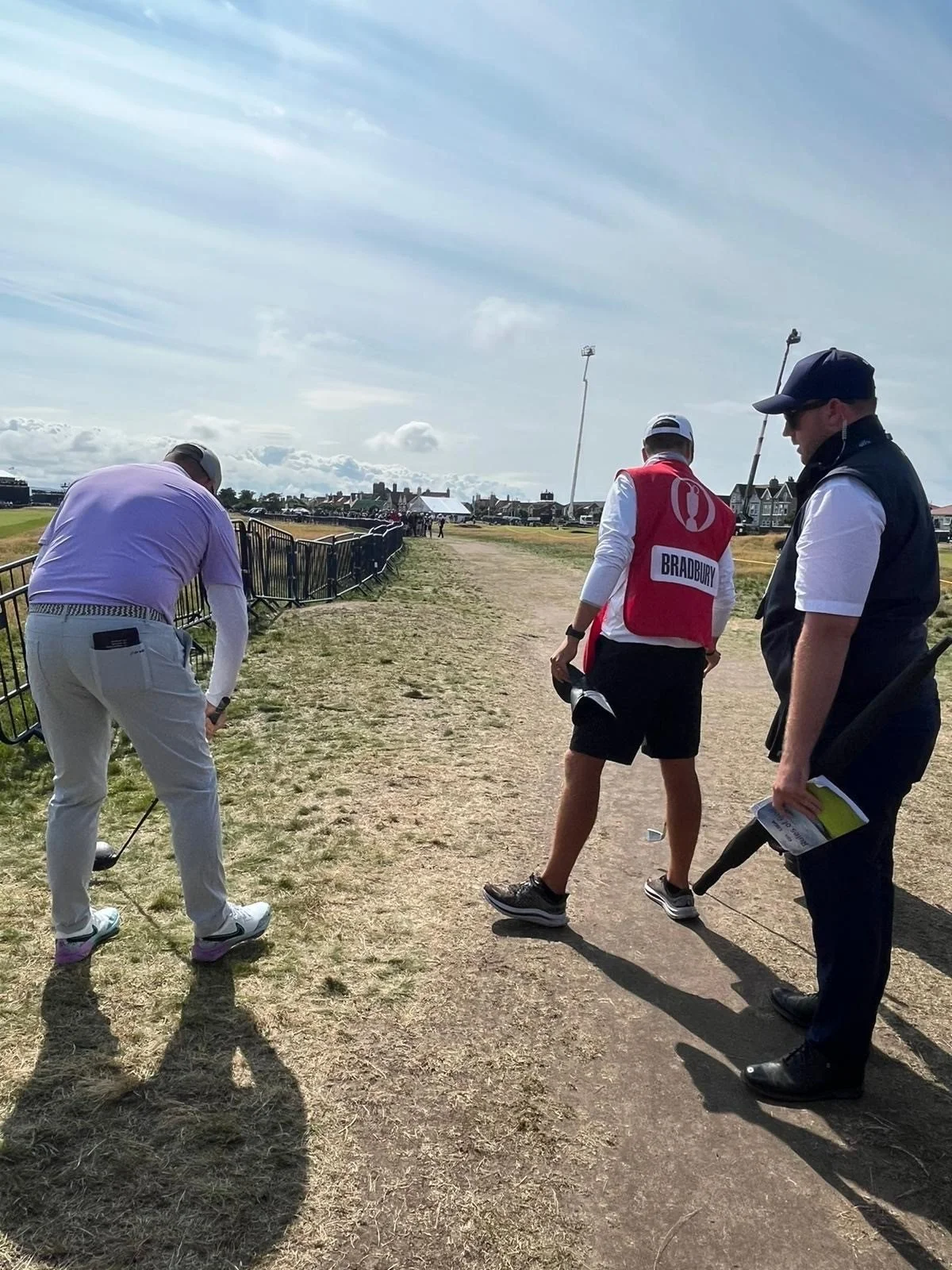INSIGHT | REFEREEING
“The hardest thing about refereeing is remaining focused. Your eyes have to be everywhere”
As The PGA’s Senior Tournament Director, Jeremy Baynham has had the chance to carry his rule book at the very highest level. He tells us about making decisions at the majors

IT must be the ultimate way to watch The Open. As a referee, Jeremy Baynham got to follow the world’s best at close quarters as the world’s oldest major was staged at Royal Troon last July.
As Senior Tournament Director at The PGA, Baynham organises and runs the Association’s flagship events such as the PGA Professional Championship and the PGA Playoffs.
But The PGA’s standing in the wider golf world also gives him the opportunity to referee at some of the world’s biggest tournaments.
Aside from Troon, Baynham has also carried his rule book at Royal Liverpool in 2023, at the last two PGA Championships (at Valhalla and Oak Hill respectively), as well as at the Ryder Cup at Marco Simone in Rome.
We sat down with him to see how he came to officiate at the highest level, find out how it’s done on that stage, and understand how he deals with the pressure of rulings in front of a live TV audience.
How does a PGA representative get a spot at these huge championships?
As an Association we have very good relationships with other governing bodies within the industry – whether that’s the PGA of America, The R&A, or the European Tour group.
We’re given an opportunity to send a member of The PGA’s rules panel or a PGA staff member to represent the Association at those events.
They’re guest referee spots. We’re very highly respected and valued within the industry for the knowledge and experience we have.
I’m fortunate in my position as Senior Tournament Director that I’ve been able to be that high-level representation from a rules base.
How does it feel to be part of those? It doesn’t get bigger than the majors and the Ryder Cup…
It doesn’t. I’m a keen golfer and have been from a young age. I’ve gone to Opens and Ryder Cups as a spectator. I’ve been there and experienced it as a fan.
To be in that really fortunate position to walk down the middle of the fairway in a Ryder Cup – with four players, four caddies, and me and maybe a scorer and a bunker raker – it doesn’t get much better than that.
Probably the hardest thing is remaining focused. Your eyes have to be everywhere. At the Ryder Cup, in matchplay, you’re looking at honour and making sure the right team are playing first.
They’re the best players in the world. To be that close and watching them hit key shots, you have to not get distracted from what you’re supposed to be doing, which is keeping an eye on the score, making sure the order of play is correct and there are no rule breaches.
You can’t get distracted by watching Europe or USA rolling it in to win the hole. You’re there to make sure nobody’s going to fall foul of the rules. I’m incredibly lucky to be a part of it.
There are obviously TV cameras and millions of viewers – how do you deal with giving a ruling under that pressure?
I think it’s experience. One of the things I really believe in is the journey and exposure you have at the right level.
You learn the basics. You work at PGA level. You get your Level 3 qualification, and you learn so much from doing that with The R&A.
You start to put that into practice. Then you get extra exposure – whether that’s starting at something like Open Qualifying – you learn a bit more and you get more comfortable with that increased amount of pressure.
You use that to step up to the Challenge Tour – where there are cameras and crowds and better players and more on the line and you use that again to prepare yourself for the next level.
It’s step-by-step development. But ultimately, you need composure and you’ve got to trust that you know what you’re doing. Giving yourself time is key too.
“To be in that fortunate position to walk down the middle of the fairway in a Ryder Cup – with four players, four caddies, and me – it doesn’t get much better than that.”
The British Masters at The Belfry was the first time I worked at a DP World Tour event. I got called to a ruling. It was on the 10th green. I wasn’t right by it, and I had a long enough journey to think ‘this could be busy’.
It’s the 10th hole at The Belfry on the Brabazon. There is going to be a camera there and you have 30 seconds of processing what you’re going to.
Then you just get your head back to the basics of ‘I’m just going to a ruling’. Whether it’s at the 10th hole at The Belfry or a ruling you’re doing for yourself at club level, you’re just applying a rule that you’ve learned over and over again and practised and implemented.
It’s just trying to channel out the elevated pressure and the atmosphere.
What’s your role at these tournaments? How are you used by the various authorities?
It’s different depending on which event you’re working at and who it is run by. If you’re on the Challenge or DP World Tour, you’d be given a buggy and a zone. That area of the course might be holes 5, 6 and 7 and you’d be responsible for manning that area and responding to any rulings.
You’d be managing the groups as they come through from a pace of play point of view and, depending on how the flow of the course is working and resourcing, you could be asked to do some monitoring or official timing and enforcing a pace of play policy.
It’s slightly different when you go to the majors. At the PGA Championship in America, you’re assigned a hole.
You would be stationed there in the morning ready for the first match to come through and be there for the entire day until the last game comes through.
You’d deal with any rulings and provide some assistance from a pace of play point of view in terms of flagging times.
The rovers are responsible for pace of play in those situations and they are the ones to speak to the groups.
At The Open, every group is assigned a walking referee. You meet the players on the 1st tee and walk all 18 holes with them and provide rules of golf assistance to them.
You’d be asked to keep track of their pace of play, to the schedule or from a position point of view with the group in front, but the pace of play element is overseen by the rovers and they are built up of the main tour referees.
They’re also a second opinion. If you’re in a situation where you’re not sure, it’s OK to stop. You might need a little bit of help and guidance, or defusing a situation might require a second opinion to do so. That’s when you would be calling these rovers.
And it’s the same principle at the Ryder Cup. You’d be given an assigned match that you would walk with. You’re the assigned referee for that match and then you’d have a selection of rovers that would oversee pace of play as well as being that second opinion.
What are the most memorable rulings you’ve given?
In some ways, you don’t want to have lots of rulings. It means everybody’s in trouble, the players are having a tough day and they’re not hitting it where they want.
That has a huge knock-on effect for pace of play. A quiet day, from a rulings point of view, is a good day.
I haven’t had anything crazy. I’ve had quite busy periods. At Oak Hill on my first PGA Championship, on the first day I was on the 6th and I didn’t really have a huge amount to do – maybe a couple of rulings.
Then I went to the 13th for round two and I probably had 30 rulings in the entire day. It was a long par 5, not quite gettable in two, and you could have some rulings from tee shots. There was a lot of hospitality and some cameras around some of the green.
If they hit a second shot slightly wide there was a huge grandstand on the right side and there were some drop zones so sometimes that took a long time to work out.
With temporary immovable obstructions, a lot of it is preparation and that’s the biggest thing I’ve learned. You need to do so much preparation.
While you’re fortunate to referee at the majors, the tournaments you run on behalf of The PGA are huge events in their own right, aren’t they?
I’m fortunate to be in my position. Working in the national tournament team I get to deliver and be the tournament director for our flagship championships – The PGA Professional Championship and the PGA playoffs.
There is a lot riding on these events and we deliver them correctly. It’s obviously not on the same scale as TV at tour level, but our day-to-day tournament administration, our thought processes in setting up a golf course, the way we interact with players on a ruling and how we apply the rules is 100 per cent the same.

Get golf business insights straight to your inbox
Sign up for the first look at the latest news, features, exclusive interviews and podcast episodes with our monthly newsletter

